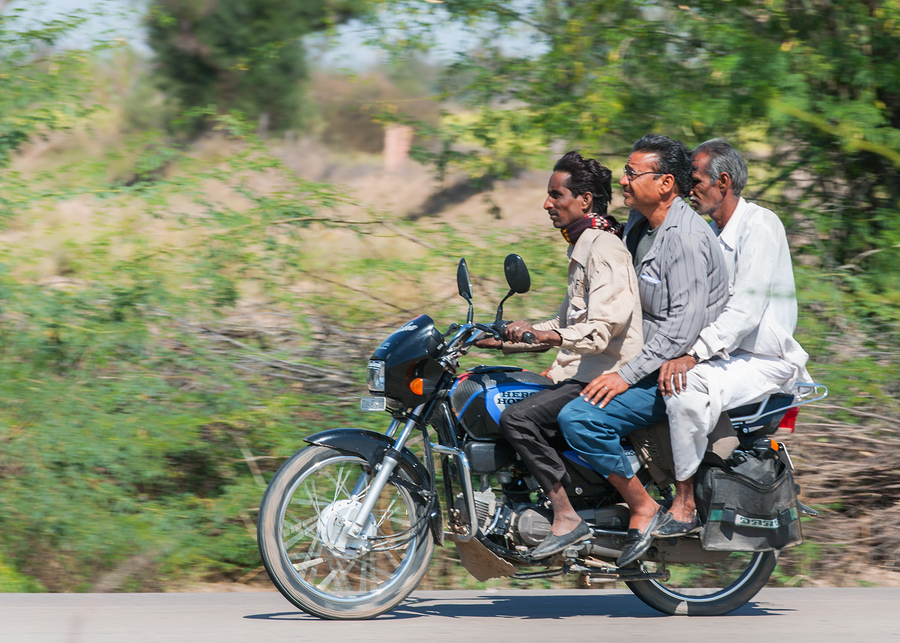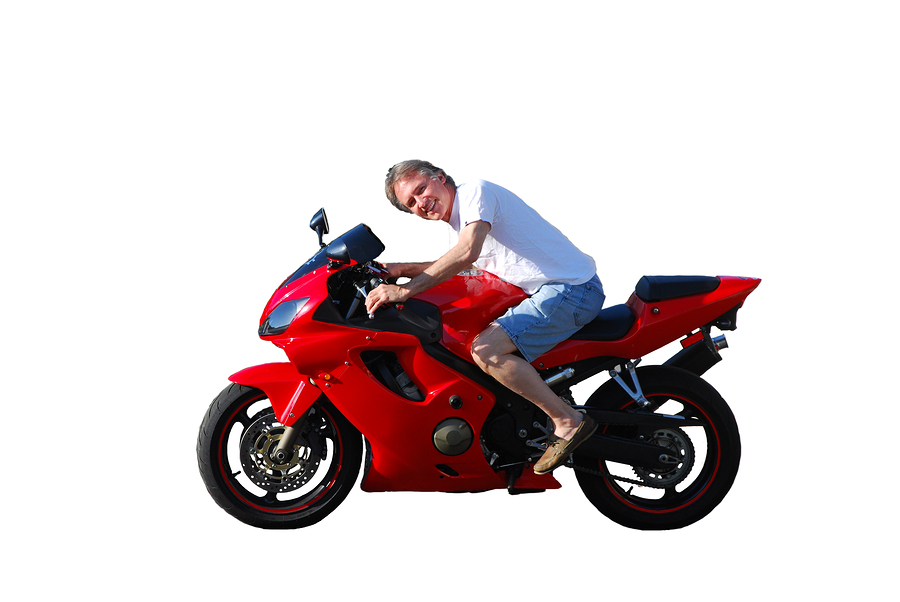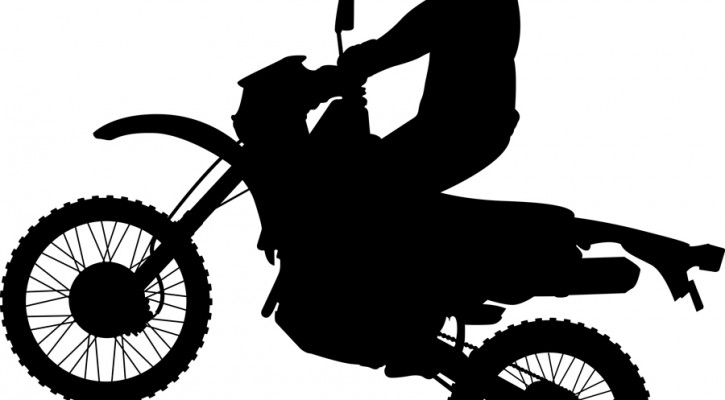
Bad Motorcycle Habits
April 23, 2015
Learn the bad motorcycle habits that cause the most motorcycle fails, and you just might make it through the first year without a dropped bike, broken bone or life-threatening injury.
Tunnel Vision
Don’t get lost in the tunnel. It’s easier than you might think. You’re cruising along with an itch for speed. You begin riding faster and faster, and you tend to focus farther and farther down the road. Pretty soon you’re travelling faster than your eyes can process, and all peripheral vision disappears. This is an incredibly dangerous situation.
Low Speed Incompetence
Many people are surprised to find out that they are terrible low speed riders. Having mastered moving at high speeds, they decided not to work on building that low speed confidence. However, it’s the low speed maneuvers that most often result minor motorcycle mishaps.
Riding Without Situational Awareness
Riding a motorcycle takes a finely-tuned mind. One must be constantly aware of their surroundings, seeing miles down the road while glancing peripherally and keeping mental notes about surroundings, road conditions and weather fluctuations. Without situational awareness, riders become road hazards.
Thinking You Know it All
The worst habit you could ever develop as a rider is developing a bad case of know-it-all-ism. No rider ever knows it all. Keep on learning, studying, and practicing. Mental agility is the key to riding safe.

In Search of a Good Mechanic
April 21, 2015
In a perfect world, all drivers would know a thing or two about engine maintenance and repairs. Along with our high school math, science and English classes, students would learn the basics of car mechanics, and be able to perform the vital tasks of vehicle maintenance before they ever stepped foot in the DMV.
However, most people know very little about what’s going on under the hood. Additionally, the basics of auto maintenance are getting far more complicated as our engines get more efficient, compact and technologically advanced. That’s why it’s so important for drivers to do the research and legwork it takes to find a good mechanic.
Where do we start?
1. Ask Around
Talk to your friends, your family, your neighbors and everyone in between.
2. Peruse the Reviews
Peruse the reviews on Yelp, Google, Angie’s List and other websites. You can find some really great, honest advice here. However, it’s best to take any online advice with a grain of salt. Many trashy, unwarranted comments make their way onto the internet. At the same time, many fake reviews are written to improve a business’s online reputation. Most of the time, the intentions are easy to spot and the truly good advice shines through.
3. Check with the Local Car Club
There are many car clubs devoted to specific makes and models. Look up the local car club listings for your car’s make, model and year number. The fine folks in these passionate car owner clubs will usually steer you in the right direction.
4. Take a Sneak Peak
Visit your local mechanics for a sneak peak into their garage. If you see clean, classic cars with rebuilt engines, you’ve probably stumbled into a passionate, dedicated mechanic. If you see a mess of rusty clunkers and disorganized chaos in a poorly lit garage, you might be dealing with poor management and unhappy workers.
5. Meet the Mechanics
Talk to the people working on your car. You’re paying good money to be able to drive. You’ve invested in a vehicle, insurance, registration and more. You will be paying for maintenance and repairs. You will want someone you can trust, as well as someone who knows how to work on your specific car. Many old timers don’t know much about newer engines and all their electronic quirks, while many younger mechanics lack the experience it takes to keep up an old, classic Chrysler.
Finding a good mechanic is like embarking on a quest for the Holy Grail. It may seem like an impossible feat, but if Monty Python could do it then so can you.
Beat the Box!
April 17, 2015
“The Box” is one of the most feared exercises of the Basic Rider Course. It is an exercise that tests the will, the skills and the sanity of every new rider, and is often the most difficult part of the evaluation to pass.
This simple, yet sometimes frustrating exercise goes like this:
- A box is marked out measuring 20′ x 20′.
- Students are asked to enter the box and make two U-Turns without using their feet to stabilize the bike.
- Students jump right in the easy-looking exercise thinking it won’t be that hard.
- Students drop their bikes, lose their confidence, and often repeat the process all day long.
As frustrating as this exercise may be, it’s an essential skill that pulls together a lot of the techniques needed in every-day riding. So the question is, how exactly do you beat the box? This video does a great job of breaking it down for you:
Remember, there’s no time limit. There’s no rush and no reason to fuss. Just take a deep breath (and don’t forget to breath it back out!) and take it nice and slow. When you U-Turn, remember to turn your head as far as possible to see where you want to end up. Always look at where you want to go and the bike will do the rest for you.
The rest is just muscle memory. Learn how to use the friction zone and throttle to give yourself enough power to pull the bike around while making sure to counter-weight with your leg on the outside peg.
Once it clicks, you’ll wonder why it was ever so difficult to begin with. However, this is a technique that should be practiced at the beginning of each new riding season so that your muscle memory stays nice and sharp.
That’s how you beat the box!
April Fools on a Motorcycle
April 1, 2015
It’s the season of the motorcycle, and for every graceful, experienced veteran motorcyclist on the road, there are at least a half-dozen fools out there. Don’t be an April Fool on your motorcycle this riding season by avoiding these riding tactics:
Lane Splitting
Lane splitting is for the impatient and the inexperienced. Many experienced riders know that lane splitting is too dangerous to be worth the risk. That’s because they have either seen a crash caused by lane-splitting, or have survived one themselves.
Riding Faster Than You Can See
This riding example comes from a snaky, back-road highway where there’s more danger than you would expect. However, big trucks and trailers making slow turns is common on back roads, and riders should always be wary of the road ahead no matter how isolated it seems.
Riding With Passengers
First of all, most motorcycles are NOT three-seaters. Secondly, new riders should avoid traveling with passengers until they have gained enough experience.
Riding Without ATGATT
ATGATT (All The Gear All The Time) should be your mantra every time you go on a ride. All the gear means helmet, gloves, boots, riding jacket and pants every time you ride!
Target Fixation
This classic case of target fixation illustrates how focusing on the side of the road just could land you there:
Turning Like a Squid
There are so many ways to take a turn the wrong way. Travelling too fast, panicking, braking at the wrong time, and overcompensating could all result in an embarrassing, if not fatal crash.
That’s six mistakes you can make this April Fools Day, and we’re just getting started. Stay tuned this beautiful spring season for more tips on how to avoid making rookie riding mistakes.
Happy April Fools Day!
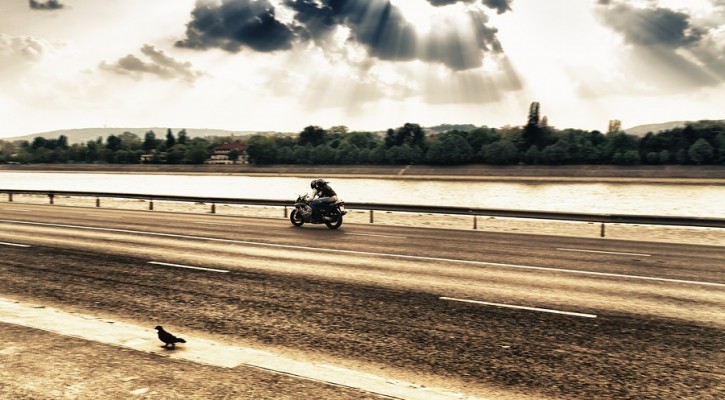
Motorcycles on Ice
March 2, 2015
With snow and ice covering most of the country right now, you wouldn’t expect to see a motorcycle on the road any time soon. Motorcycles aren’t the best vehicle for winter driving. However, with the right gumption, gear and know-how, riding enthusiasts can enjoy their motorcycles in just about any weather.
Here’s how:
Know the Temperature
Knowing exactly how cold your riding climate is will be vital. The temperature you feel walking outside is drastically warmer than the temperature you feel at 60 mph. This chart from rom the National Weather Service can give you some idea of what you are up against.
Remember ATGATT
Wearing All The Gear All The Time is always important. In the winter, wearing all the gear all the time is sure to make things warmer as well. From thick, insulated helmets to wind-blocking motorcycle suits to tough-as-nails riding boots, the very same gear that keeps you safe in the summer is sure to keep you warm in the winter.
Dress for the Part
Because wind has such a high impact on your body temperature, deflecting it is the highest priority. From the head down, every inch of your body needs to be shielded from the elements.
The helmet is your windproof shell for the head. Besides blocking the wind and protecting your noggin from the asphalt, it also provides a thick layer of insulation that’s perfect for keeping warm. You can add to that insulation by incorporating a ski mask, scarf, or bandanna. However, make sure you leave a little room for fresh air to get in or you may run out of oxygen.
For the body, windproof snow gear and leather outer layers are great for cold rides. Layer up with wool, fleece and thermal liners on the inside, and remember to wear a good belt to keep wind from creeping up your back.
Add Heat
This is such a wonderful modern world we live in. These days, motorcyclists can find electric apparel to warm up their wintry rides. Companies such as Aerostich, Gerbing and Widder make electric riding clothes that attach to the bike’s electrical system for wearable heating. There are electric jackets, gloves and vests available. Although you may be tempted begin the electric clothing collection with gloves, the vest actually provides the most warming benefit. Riders say that an electric vest can make the weather more comfortable, allowing them to ride in conditions much colder than they would attempt otherwise.
You can also add heat with good old fashioned hand warmers, which can be stuffed into gloves, pockets and socks. These classic little warmers work great and can last up to 10 hours.
Control Moisture
With all this heavy gear on, you’re sure to get a little hot before hitting the road. Perspiration can have a negative effect on your ability to stay warm once you’re riding. However, wearing the proper underclothes can help with this issue. The outdoor clothing industry includes a large selection of socks and underwear specially designed to wick away moisture. Wool is also great for keeping the heat in while allowing enough air circulation to keep things nice and dry.
Hands and Feet
For the same reason, I like to wear waterproof boots and gloves. I have a roomy pair of boots I press into service with heavy socks during rides that promise cold. If your only riding boots are lightweight and offer neither waterproofing nor room for extra socks, a pair of hiking or similarly heavy boots (especially a pair with insulation) may be a better bet. By the way, wearing your pants outside your boots keeps you much warmer than vice versa.
There are a number of gloves that meet my waterproof, cold-stopping criteria, with two-finger gloves and electric gloves topping the warmth meter — if they allow for a good feel on the controls. Leather for its crash protection, and a firm retention system is also high on my list of desirable glove attributes. Gauntlets that fit snugly over the sleeves of your jacket are essential. Since those sleeves may be fairly bulky, they may require gauntlets that seem awfully large on their own. Lightweight liners worn under the gloves can improve warmth by controlling perspiration and keep your hands comfy at gas stops, etc.
Another effective device for keeping your hands warm are covers that attach to the handlebar and completely enclose the grip area and your hands, such as Harper Hands offered by Chase Harper. These pods are most useful for riders who ride regularly in very cold weather.
Beware of Ice
Watch out for those bridges that freeze before the roads do, and be alert for black ice in shady areas. If you must cross an icy patch or even a suspected one, keep the bike slow, straight and steady. Squeezing in the clutch and free-wheeling across the ice will keep you from applying either too much or too little power to the rear wheel. As a rule, you will be steadier with your feet on the pegs or floorboards than dragging them. Also watch for sand placed in corners to deal with the ice.
If you have the proper gear and avoid the slick spots, riding in cold weather can be as comfortable and fun as riding on warm days. And the investment you make in cold-weather gear simply enhances your investment in your bike.
Remember, winter riding is not for the novice motorcyclist, or for the faint-of-heart. If you’re still a beginner on the bike and are interested in winter riding, then now is the time to begin preparations for next year’s winter adventures.
The Essence of Motorcycling
February 18, 2015
There are a few keys to understanding the essence of motorcycling. So before you hit the road, keep these thoughts in mind:
Ride as if you’re already where you need to be.
If you’re on the bike, you’re never in a hurry to get anywhere. It’s a great cliché but very important in this case: better late than never. Haste makes us do stupid things, so when you’re riding, you’re riding. Imagine that the destination doesn’t exist, that you’re just there to be on the road!
Take the point of view that any accident or mishap is your fault.
Yes you may legally be in the right in a collision, but there are cemeteries full of blokes who were in the right. Car pulled out on you and caused you to hit the brakes hard? Your fault for not anticipating and being ready for it. Car changed lanes and nearly took you out? Why were you in a position whereby it mattered what the car did?
Ride like you’re invisible and everybody else is drunk.
Car drivers, at least the ones who aren’t texting, fighting with their spouse on the phone, applying make-up or messing with their iPods, are looking for moving objects the size of cars and trucks. A motorcycle is a much smaller thing and might not even register with a driver. And since so many cars are wired to have their lights on all the time, even the bike’s headlight doesn’t make it stand out in traffic. Never assume that the car driver sees you. Always assume that the car driver will do something dumb. Be ready for it. Plan accordingly.
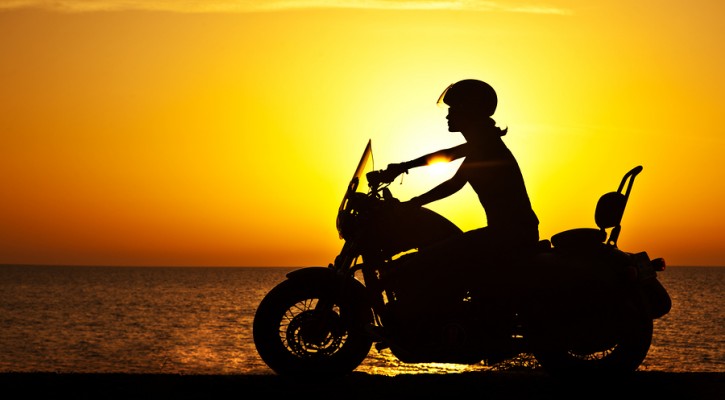
How to Beat the Winter Biker Blues
January 11, 2015
With winter in full force, there’s not much a motorcyclist can do but wait for the snow to clear. That is, until you’ve read this cheat sheet on beating the Winter Biker Blues:
Head South
If you have time to travel this winter, then take a trip down south where the weather is always perfect for riding. Sunny coastlines rarely see temperatures dip below freezing in the winter, and are often a mild 60 to 70 degrees during the daytime. Don’t want to tow your ride all the way to Florida? That’s alright. Just take a test drive at the local dealership, or rent a bike for the day in Key West.
Plan Rides
The best way to make time pass on a cold winter night is to plan your upcoming summer road trip. Do you dream of trekking cross-country? How about a quick day-trip through the hills? Or maybe an international trip through South America? Start planning and saving now, and you will be ready to roll as soon as the ice melts.
Prep Bike
Winter is the perfect time for motorcycle maintenance. If you can’t ride, then you might as well prep your bike so you will be ready to ride in the spring. If you haven’t already winterized your motorcycle, then now would be a good time. You can also give your ride a good wash, as well as go through the essential motorcycle maintenance checklist. In fact, performing at least one annual maintenance check could keep your motorcycle running forever.
Check Gear
Not only does motorcycle gear wear out, but it also becomes outdated pretty quickly. Every year there is newer, better, safer equipment, as well as higher safety standards in the industry. That’s why it’s important to check your gear each winter. You certainly don’t want to be caught with a faulty helmet or torn boots when riding season comes around. Now is the time to take stock of what you need and start saving for new gear in the spring. Or if you have the cash on hand, buy new equipment now and take advantage of winter savings.
Watch these videos
When the ride is planned, the gear checked, the motorcycle cleaned and prepped, and there’s nothing else to do but wait, that’s when it’s time to check out these riding videos for inspiration:

Real Life Questions and Answers: Car Trouble
January 9, 2015
If my vehicle breaks down, how long can I leave it on the side of the road?
This is an excellent question. The short answer is: it depends.
The length of time you can leave a vehicle on the side of the road varies greatly from state to state and city to city. Depending on your location, you may have as little as a few hours or as much as a few days to move the vehicle.
It’s important that you make every effort to park the vehicle where it does not impede traffic. If that is not possible, then it will be towed immediately, often for a hefty fee.
If the vehicle is parked safely on the shoulder or side of the road, then you have considerably more time. Most police officers try to remove a vehicle parked on the side of a busy interstate within 4 to 6 hours. If it’s parked on the side of a regular road, then they will tag it and tow it within 24 to 72 hours.
The best way to answer this question in your local state is to go to the official state website and search for “abandoned vehicle”. For example, a search for “abandoned vehicle” on Texas.gov gives us this:
“Sec. 683.002. ABANDONED MOTOR VEHICLE. (a) For the purposes of this chapter, a motor vehicle is abandoned if the motor vehicle:
(1) is inoperable, is more than five years old, and has been left unattended on public property for more than 48 hours;
(2) has remained illegally on public property for more than 48 hours;
(3) has remained on private property without the consent of the owner or person in charge of the property for more than 48 hours;
(4) has been left unattended on the right-of-way of a designated county, state, or federal highway for more than 48 hours;
(5) has been left unattended for more than 24 hours on the right-of-way of a turnpike project constructed and maintained by the Texas Turnpike Authority division of the Texas Department of Transportation or a controlled access highway; “
While a search for “abandoned vehicle” on the Tennessee website (tn.gov) gives us this:
“If you encounter an emergency that requires you to abandon your vehicle on the side of the road, try your best to leave the vehicle in a location that does not impede traffic. Again, turning your wheels to the right is a good idea.”
“Tennessee law states you have 48 hours to remove a vehicle before it is towed. Abandoned vehicles may be legally removed from the roadway if left for more than 48 hours. However, if a vehicle is left in a place that interferes or impedes traffic, that vehicle can be towed immediately. If towed by THP, the vehicle will be taken to a local towing lot. You can contact the THP District Headquarters in the area where you left your car to find out where the vehicle was towed.”
It’s always best to fix or tow your vehicle as soon as possible to avoid tickets, towing fees, and impound lot fees, as well as prevent damage from criminal activity.
If you have a question you would like answered on our Real Life Questions and Answers series, then feel free to post your inquiries on our Facebook page.

New Year, New Laws
January 5, 2015
Every year motorists face new laws and regulations, especially when it comes to motorcyclists. This year, a handful of states have new laws on the books that riders need to know:
ILLINOIS – Amended the definition of motorcycle to include autocycle, defined as a three-wheeled motor vehicle that has a steering wheel and seating that does not require the operator to straddle it. Operation of an autocycle requires a Class D driver’s license.
INDIANA – Motorized cycles and mopeds must now be registered under one of two classes: over 50cc and 50cc and under. Operators of both types of vehicles must show proof of ownership and wear helmets if they are under 18 years of age. Operators of over-50cc vehicles are required to carry liability insurance and must have a valid driver’s license with motorcycle endorsement. Riders of 50cc-and-under vehicles must be 15 years of age or older and have a valid Indiana state ID card with a motor driven cycle Class B endorsement, learner’s permit or driver’s license. Continue Reading

A Worthy New Year’s Resolution: Put the Phone Down
December 30, 2014
The best New Year’s Resolution we’ve heard this year comes from a teen driver in Texas: A resolution to put the phone down and be more present.
People get tunnel vision when it comes their phones. Rather than enjoying a concert, a party, or time with friends and family, their concentration is directed towards the glowing screens of their cell phones. They miss important conversations, epic performances, and experiences they will never be able to get back. That’s why this New Year’s Resolution is so beautiful. Without a constant connection to the phone, this college freshman will be able to truly enjoy every minute of 2015.
Another reason we love this New Year’s Resolution: there will be at least one safe driver on the road this year. There will be at least one person driving that isn’t checking their cell phone for missed calls, text messages, facebook updates or Snapchat posts. Rather than looking down at her phone, this driver will have her eyes on the road. If only the rest of the drivers out there were so enlightened.
It is true that some phone calls and text messages are important – life changing, even. However, there’s no reason why these conversations can’t wait, especially if you are driving a vehicle. So let’s all take a lesson from this savvy Texas girl and put the phone down… if only in the car.

